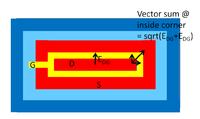Tbit
Newbie level 3

The enclosed gate layout (ELT)of a MOS transistor is a popular physical implementation in mitigating the effects of TID (ionising radiation) on normal device operation in Space/Cosmic environments.
A couple of questions:
1/ I would appreciate knowing where I can find detailed classic information on the principle of the MOS enclosed gate layout structure to mitigate TID effects?
2/ If the modelling of this ELT structure is accounted for in any BSIM/Compact Spice model then what are the parameters involved and how do they differ from the BSIM model of a normal MOS transistor layout?
A couple of questions:
1/ I would appreciate knowing where I can find detailed classic information on the principle of the MOS enclosed gate layout structure to mitigate TID effects?
2/ If the modelling of this ELT structure is accounted for in any BSIM/Compact Spice model then what are the parameters involved and how do they differ from the BSIM model of a normal MOS transistor layout?


